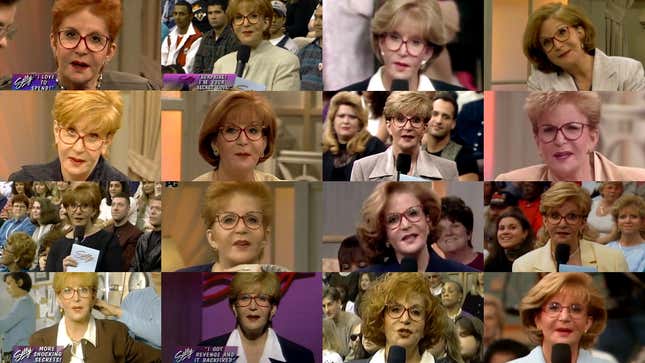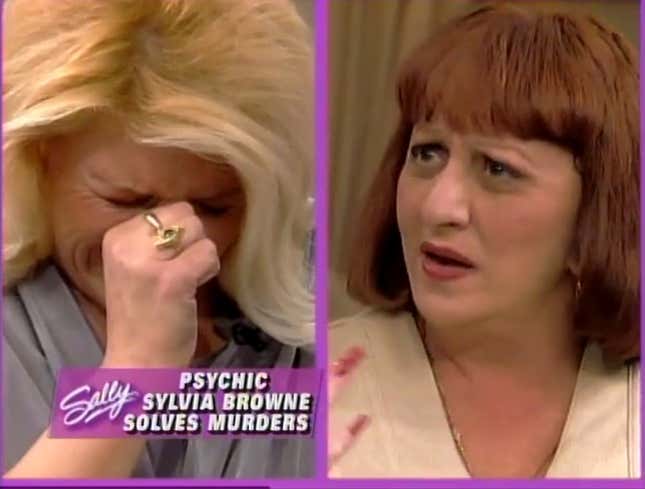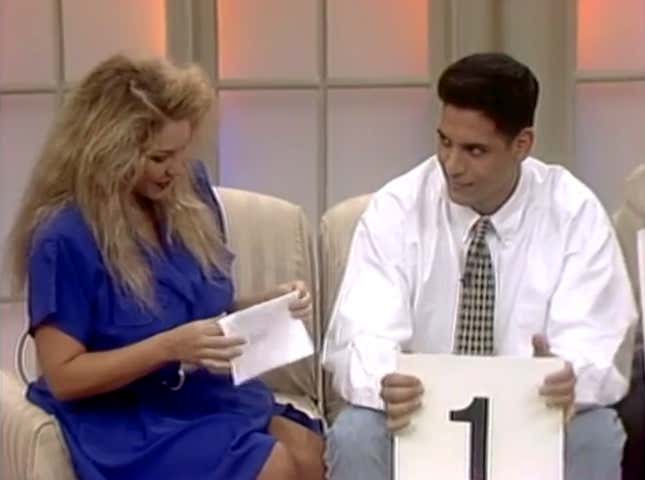

For some reason, there are 233 episodes of the classic daytime talk show Sally (originally titled The Sally Jessy Raphaël Show) streaming amongst episodes of Jerry Springer, Maury, and Divorce Court on the trash-TV platform Nosey. On that free streamer, Sally is virtually the only show of its kind: A general interest talk show whose guests and topics are (mostly) plausible and presented with no threat of the entire operation devolving into professional wrestling.
Though most of these Sally episodes seem to span the years of 1995 to 1997, they retain the essence of ’80s talk shows. While frequently tense and not at all short on drama, they remain sick-day soothing, a portal to a time when things were simpler and when people went after mic-drop clout by telling others exactly what they thought of them to their faces.
Watching a handful of Sally episodes recently, it struck me how efficient a vehicle the now outmoded talk show format once was. You can detect the roots of so much of what came to flourish in pop culture. The salacious daytime talk show was the missing link between the sideshow of old and reality TV, for offering the opportunity to gawk at humanity without adulteration. That the episodes are largely populated by inexperts who pull no punches in pontificating on whatever the fuck, whether it’s based in reality or not, makes the format a precursor to podcasting. Here’s one of the subjects of “I’m Proud That I Date Married Men” claiming that one incentive of doing so is that it allows her to find partners with bigger penises:
The call-response format—that is, after the guests laid out their identities as they applied to the topic of the show, the audience lined up to have their say—was a nascent and IRL version of Twitter discourse. People brutally weighed in on each other, seemingly motivated as much by self-expression as the applause that dunking on someone would elicit. It’s difficult to imagine a contemporary entertainment journalist going as hard on Robin Quivers, Howard Stern’s co-host who was criticized for standing by while Stern made racist jokes in his early years on air, as the audience member does here:
The palpable pride of so many guests in sharing that thing about them that makes them special enough to discuss on television is not unlike that which frequently evinced during the golden age of the personal essay on blogs in the early 2010s. Both the talk show and the personal essay cut to and then through the heart of Middle America, operating under the premise that we all have something special about us, even the most “normal”-seeming members of society. You can even see the origins of how so-called “identity politics” came to play themselves out online: guests define themselves per the day’s topic, they defend said identity, and they argue why it’s important for you to know this. There’s also a lot of subsequent, “You don’t know me, you can’t judge me!”-style indignance when they fail to persuade and the audience registers its disapproval.
There are a lot of “bad teens” episodes in this bunch, a lot of makeovers coordinated by the show (“Help! My Husband’s the King of Slobs”) and not (“I was a Nerd…Now I’m a Knockout”), a lot of pregnancy-adjacent issues…
…and a bit of “psychic” fraudster Sylvia Browne.

Browne had the nerve to purport to name and rattle some of the license plate number of a hit-and-run driver who killed one guest’s baby. As someone wholly invested in the identity that brought her to the show, Browne was the quintessential Sally guest (though said identity was not up for debate, as it was for the normie guests).
There were also a lot of surprise reveals, which often led to humiliations of unsuspecting guests. It apparently wasn’t clear at the time that telling your fiancé you had an affair in front of a live audience might not be the most constructive way of handling that issue. Likewise, though Sally frequently explored queer issues (its host was mostly empathetic and game to use proper pronouns, even), the mid-’90s were a time when it was still completely socially acceptable for straight people to register their disgust of queer people without risk of backlash. “That’s wrong because I, as a straight man, said so,” was so often taken as a completely reasonable rationale, which gives a lot of the queer-themed shows a tedious you-have-to-hear-all-sides flavor. That said, watching a trans woman fearlessly shred a bigot remains exhilarating and, given the mores of the time, comes off as astonishingly brave.
Speaking of mores, it can be absolutely shocking to revisit how casual people were about being attracted to people under the age of 18. On “She’s Not My Grandmother, She’s My Lover,” a 32-year-old man discussed a relationship he had with a 19-year-old, whom he said, without shame or retribution, that he had been with for four years—since she was 15. Contrast that being received as a non-issue with the mini-controversy The Drew Barrymore Show ignited last year when it turned out that guests married on the show had allegedly met when the husband was the bride’s high school teacher. On “Surprise! I’m Your Secret Love!,” a 25-year-old woman confessed her crush on a 16-year-old boy that she’d known since he was 12. This was received without scandal.
It was a different time! That’s not an excuse but an explanation, and also an indication that the talk show was not the best venue to adjudicate many of the issues it took on, especially those surrounding sex and gender. Raphaël could be passionate (as when staring down a teen whose goal was to be the “baddest kid in the world”) or compassionate (she frequently sat next to her guests as they poured out their hearts before summoning someone they knew whose presence on the stage would complicate their story and maybe humiliate them). She sometimes allowed the crowd’s comments to go on for way too long, and chaotic crosstalk was a frequent feature of her show. Mostly she acted as a conduit for discussion—her job in its most basic sense—and as such existed in a vagueness, a human cloud floating around to shift the barometric pressure in the studio. There’s a reason why her red glasses have long been her most noted quality.
At its best, Sally is an inadvertent compendium of ridiculous ’90s fashion (look at how billowy men wore their dress shirts)…

…and a celebration of the inherent entertainment value in humanity. It’s a place to watch lives get ruined, yes, but it’s also a place to watch them contort into previously unimaginable arrangements. One episode featured a guest who brought footage from a wedding she had for her horse (to another horse). The officiator claimed the horses were “legally married with a wedding certificate” and then prompted her dachshund to “sing” their wedding song (“Makin’ Whoopee”).
Beyond the gravitational pull of nostalgia, Sally works as a reminder to not take things so seriously, even as it takes itself highly seriously (as do its guests). In “My Husband Left Me Because He’s Gay,” a woman recounts discovering evidence that her husband was sleeping with a man. Her immediate reaction, she said, was to listen to “When a Man Loves a Woman” on repeat. The audience laughed in response. Sometimes it’s all you can do.